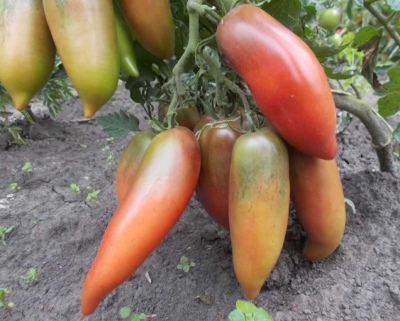
- Authors: Ohio, USA
- Appeared when crossing: Sausage green x Cherokee purple (Green sausage x Cherokee purple)
- Name synonyms: Wessel's Purple Pride, Cherokee Sausage, Wessel's Purple Pride, Wessel's Purple
- Category: grade
- Growth type: indeterminate
- Appointment: fresh consumption, for canning in slices, for juice, for ketchup and tomato paste
- Ripening period: mid-season
- Ripening time, days: 110-120
- Growing conditions: for greenhouses
- Transportability: high
We are all used to seeing tomatoes red and round. But thanks to the knowledge of scientists from the United States, a purple-colored and elongated tomato variety appeared. They are as tasty and juicy as their brethren.
Description of the variety
This variety was created by American breeder Markus Wessel. The shape resembles a little bell pepper, at the time of ripening it acquires a burgundy-purple color. For this, it was named Wessel's Violet Pride. This tomato is very fond of warmth and light, so it is better to grow it in a greenhouse. One bunch can have 5-7 fruits. The plant has a tall, slender bush, spreading foliage and a rich harvest.
There are other pluses:
bountiful harvest;
strong fruits;
not afraid of frost;
resistance to weather changes;
unpretentious in care;
suitable for canning.
The main qualities of the fruit
Fruits are elongated in shape, with a pointed nose. Medium fruits weigh 120-250 g, and large tomatoes 300 g each, reach 12 cm in diameter. The color when ripe is green, then it acquires a purple color with purple hues. The color can be pink-violet or purple-brown-violet. They have dense skin and juicy flesh.
Taste characteristics
The taste of tomatoes is rich, sweet, slightly sour and with a delicate fruity aroma. Tomatoes are suitable for fresh consumption and preparation of dishes and juices, as they practically do not have seeds.
Ripening and fruiting
Tomatoes of this variety usually ripen after 110-120 days from germination.
Yield
From 1 m2, you can get about 11-12 kg of the crop. To get the maximum yield, you must:
apply fertilizer 2 times a month;
water 2 times a week;
do pinching in a timely manner and leave 2-3 stems.
The timing of planting seedlings and planting in the ground
Since it is a thermophilic variety, it requires seedlings to begin with. The seeds can be prepared in early March. The soil must be enriched with useful fertilizers so that humus, sand and peat are present in them. The place for seedlings should be sunny and warm. Sowing pots measuring 10x10 cm.
Seeds should be placed 2 cm deep and sprinkled with room temperature water. Cover the pots with foil, put in a warm, sunny place, the seedlings should be periodically ventilated. Remove the film only when the first shoots appear. You can transplant the shoots when 2-3 leaves appear - this is necessary to strengthen the root system. Place the planted sprouts in a warm, bright place for 2 months. Make sure that the ground is not dry.
Seedlings can be planted in mid-May in a greenhouse or in open ground, preferably together with clods of earth. The land should be sheltered from the winds and be sunny, not shaded.

Growing tomato seedlings is an extremely important process, because it largely depends on whether the gardener can harvest at all. All aspects must be taken into account, from seedbed preparation to planting in the ground.
Landing scheme
For planting, the land must be fertilized with organic fertilizers. Depressions are made in the ground and seedlings are transplanted into them along with the ground. Plant 4 plants per m2. After transplanting, it is necessary to water the seedlings with water at room temperature. If the weather is cool during planting, then it is better to cover the seedlings with foil or agrofibre.

Growing and caring
Growing a good crop requires proper care. It includes 4 stages:
watering;
tying up;
top dressing;
the formation of bushes.
Watering must be done regularly and making sure that the soil is not dry. You should also not water a lot. After watering, it is advisable to loosen the soil so that excess moisture evaporates and rot does not form.
Since the variety has high stems, it must be tied to a trellis, or you can use an agro-mesh. You can also supply self-made supports.
For feeding, mineral fertilizers are needed. The root system is in great need of them, which, with a shortage, cannot feed the upper part of the bush, and then the harvest will turn out to be weak. Top dressing is done in several stages:
during the flowering of brushes, the plant should be fertilized with preparations containing fluoride;
during the filling of fruits, preparations containing nitrogen and potassium are needed;
when the rest of the brushes begin to bloom, add fertilizer with fluoride again;
before harvesting, as well as during the ripening of fruits, the plant needs potassium.
It is necessary to form a bush so that the central trunk can receive nutrients. The lateral processes that appear take away a lot of strength from the plant, create extra density and interfere with the natural circulation of air. The bush should consist of 2 stems, one of which should be slightly lower. 3 brushes are usually formed on it.




A plant needs different micronutrients at each stage of growth. All fertilizers can be divided into two groups: mineral and organic. Folk remedies are often used: iodine, yeast, bird droppings, eggshells.
It is important to observe the rate and period of feeding. This also applies to folk remedies and organic fertilizers.


Review overview
First of all, many people note the taste of this variety, that the tomatoes are tasty, soft and fleshy. The plant does not get sick, brings a bountiful harvest even when grown outdoors. Anyone who likes tomatoes recommends using them for fresh salads.

























































































